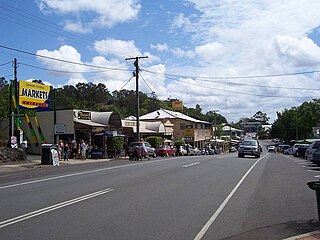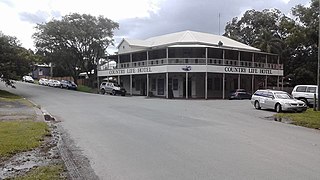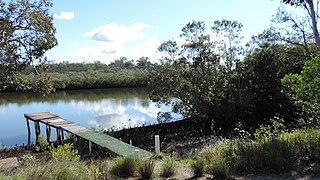
Palmwoods is a rural town and locality in the Sunshine Coast Region, Queensland, Australia. In the 2021 census, the locality of Palmwoods had a population of 6,357 people.

Glass House Mountains is a rural hinterland town and locality in the Sunshine Coast Region, Queensland, Australia. In the 2016 census, the locality of Glass House Mountains had a population of 5,065 people.

Mapleton is a rural town and locality in the Sunshine Coast Region, Queensland, Australia. In the 2016 census, the locality of Mapleton had a population of 1,564 people.

Eumundi is a rural town and locality in the Sunshine Coast Region, Queensland, Australia. In the 2021 census, the locality of Eumundi had a population of 2,504 people.
Montville is a rural town and locality in the Sunshine Coast Region, Queensland, Australia. In the 2016 census, the locality of Montville had a population of 970 people.

Woombye is a rural town and locality in the Sunshine Coast Region, Queensland, Australia. In the 2021 census, the locality of Woombye had a population of 3,944 people.

Kin Kin is a rural town and locality in the Shire of Noosa, Queensland, Australia. In the 2016 census, the locality of Kin Kin had a population of 764 people. In the 2021 census the population had risen to 844.

Lake Macdonald is a rural locality in the Shire of Noosa, Queensland, Australia. In the 2016 census Lake Macdonald had a population of 1,363 people.
Diddillibah is a semi-rural locality in the Sunshine Coast Region, Queensland, Australia. In the 2016 census, Diddillibah had a population of 1,403 people.
West Woombye is a rural residential locality in the Sunshine Coast Region, Queensland, Australia. In the 2016 census West Woombye had a population of 1,007 people.
Kiels Mountain is a rural locality in the Sunshine Coast Region, Queensland, Australia. In the 2016 census, Kiels Mountain had a population of 664 people.

Coochin Creek is a coastal locality in the south of the Sunshine Coast Region, Queensland, Australia. The locality is named for the creek which flows through it.
Landers Shoot is a rural locality in the Sunshine Coast Region, Queensland, Australia. In the 2016 census, Landers Shoot had a population of 252 people.
Hunchy is a rural locality in the Sunshine Coast, Queensland, Australia. In the 2021 census, Hunchy had a population of 592 people.

Rocksberg is a rural locality in the City of Moreton Bay, Queensland, Australia. In the 2016 census, Rocksberg had a population of 300 people.

Villeneuve is a rural town and locality in the Somerset Region, Queensland, Australia. In the 2021 census, the locality of Villeneuve had a population of 193 people.

Witta is a rural town and locality in the Sunshine Coast Region, Queensland, Australia. In the 2021 census, the locality of Witta had a population of 1,296 people.
Kidaman Creek is a rural locality in the Sunshine Coast Region, Queensland, Australia. In the 2016 census Kidaman Creek had a population of 130 people.
Kureelpa is a rural locality in the Sunshine Coast Region, Queensland, Australia. In the 2021 census, Kureelpa had a population of 968 people.
Blackall Range road network is a group of roads that provide access to the mountain localities and towns from various lowland places, and enable travel between the mountain communities. The network ensures continuity of access in times of flooding or other natural disasters, and during planned maintenance activities. The area serviced by the network includes the localities and towns, from south to north, of Maleny, Montville and Mapleton. It also includes the rural localities of Bald Knob, Balmoral Ridge, Flaxton, Gheerulla, North Maleny, Obi Obi and Witta. The area hosts a substantial residential community plus many tourism accommodation venues. At the 2021 census, the locality of Maleny had a population of 3,959 people.














